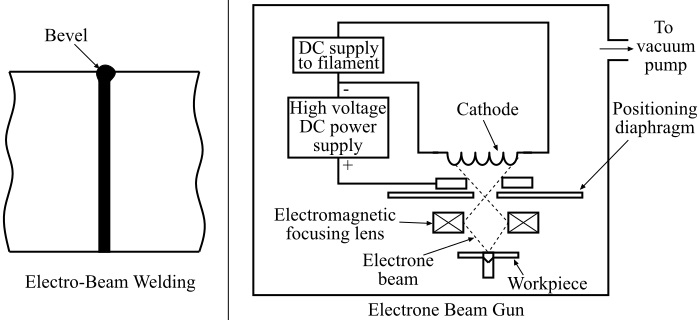
 Data Structure
Data Structure Networking
Networking RDBMS
RDBMS Operating System
Operating System Java
Java MS Excel
MS Excel iOS
iOS HTML
HTML CSS
CSS Android
Android Python
Python C Programming
C Programming C++
C++ C#
C# MongoDB
MongoDB MySQL
MySQL Javascript
Javascript PHP
PHP
- Selected Reading
- UPSC IAS Exams Notes
- Developer's Best Practices
- Questions and Answers
- Effective Resume Writing
- HR Interview Questions
- Computer Glossary
- Who is Who
Electron Beam Welding: Working Principle, Advantages and Applications
Electron Beam Welding
Electron beam welding (EBW) is a welding process in which a beam of high velocity electrons is applied to the materials being joined or fused. When these high velocity electrons impact the workpieces, the kinetic energy of the electrons is transformed into heat, which melts the workpieces.
The first practical electron beam welding machine was developed by a German physicist Karl-Heinz Steigerwald in 1958. In order to prevent the distortion of the electron beam, the electron beam welding is performed in vacuum.
Working Principle of Electron Beam Welding
A typical schematic of the electron beam welding (electron beam gun) is shown in the figure below.

In electron beam welding, when a cathode in a vacuum is heated by a filament, it emits a beam of high velocity electrons. These electrons are further accelerated by voltage and are converged by an electromagnetic coil. When the electron beam strikes the workpiece, the kinetic energy of the electrons is converted into heat. This heat energy generated is then utilized for welding process.
For a typical electron beam welding machine, the diameter of the beam spot is about 0.2 mm. The electron beam welding allows less distortion, as the heat applied to the area around the weld is low.
Advantages of Electron Beam Welding
The advantages of the electron beam welding are given as follows −
The electron beam welding process eliminates the atmospheric contamination of both the weld zone and the weld bead, as it is performed in the vacuum.
Electron beam welding consumes low power, therefore, its operating cost is low.
It produces narrow electron beam that reduces the distortion of the workpiece.
Electron beam welding is the only process that can be used to join high temperature metals like columbium.
Electron beam welding has high deposition rate. Therefore, its single pass can produce welds of excellent quality.
Electron beam welding produces deep penetration with very less distortion.
Applications of Electron Beam Welding
Some of the applications of the electron beam welding are given as follows −
The adjustment of penetration can be controlled by controlling the electron beam output, thus the electron beam welding is applicable to a wide variety of base materials, from thick to thin sheets.
Metals having high melting points like tungsten can also be welded by using the electron beam welding.
Electron beam welding can be used for active metals such as titanium which may oxidize during the welding process.
Electron beam welding is widely used in various industrial applications such as for welding of electronic components, bridges, aircraft parts, ship’s shells, etc.

